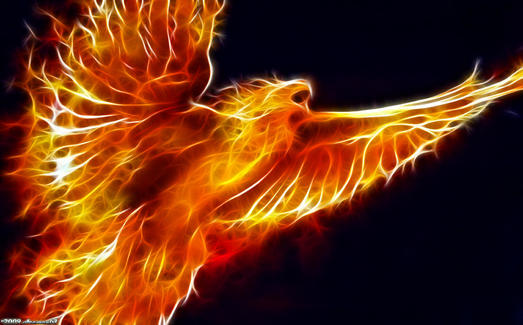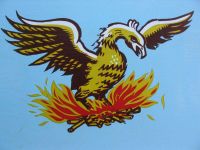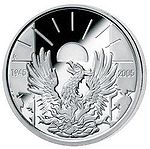Sign in or 

| Version | User | Scope of changes |
|---|---|---|
| May 22 2016, 9:29 PM EDT (current) | Egalitaria | |
| May 22 2016, 3:46 PM EDT | Egalitaria | 9 words added, 831 words deleted, 1 photo deleted |

 The first Greek known to have mentioned the phoenix was the poet Hesiod, in The precepts of Chiron stresses the phoenix's longevity to almost 100,000 years.
The first Greek known to have mentioned the phoenix was the poet Hesiod, in The precepts of Chiron stresses the phoenix's longevity to almost 100,000 years.A chattering crow lives out nine generations of aged men,
but a stag's life is four time a crow's,
and a raven's life makes three stags old,
while the phoenix outlives nine ravens,
but we, the rich-haired Nymphs
daughters of Zeus the aegis-holder,
outlive ten phoenixes.

Most beings spring from other individuals; but there is a certain kind which reproduces itself. The Assyrians call it the Phoenix. It does not live on fruit or flowers, but on frankincense and odoriferous gums. When it has lived five hundred years, it builds itself a nest in the branches of an oak, or on the top of a palm tree. In this it collects cinnamon, and spikenard, and myrrh, and of these materials builds a pile on which it deposits itself, and dying, breathes out its last breath amidst odors. From the body of the parent bird, a young Phoenix issues forth, destined to live as long a life as its predecessor. When this has grown up and gained sufficient strength, it lifts its nest from the tree (its own cradle and its parent's sepulchre), and carries it to the city of Heliopolis in Egypt, and deposits it in the temple of the Sun.
It was of the size of an eagle, but its eyes were as mild and tender as those of the eagle are fierce and threatening. Its beak was the color of a rose, and seemed to resemble, in some measure, the beautiful mouth of Formosante. Its neck resembled all the colors of the rainbow, but more brilliant and lively. A thousand shades of gold glistened on its plumage. Its feet seemed a mixture of purple and silver; and the tail of those beautiful birds which were afterwards fixed to the car of Juno, did not come near the beauty of its tail.
Related usage
In Persian mythology, Simurgh, (Persian: سيمرغ, Middle Persian: senmurv) was a winged, bird-like creature that was very large and extremely ancient. The Simurgh appears in many Iranian literary classics such as Farid ud-Din Attar's Conference of the Birds as instructor and birds leader, and in Ferdowsi's epic Shahnameh (The Book of Kings); Simurgh raised up and cherished Zaal or Zal, father of Rostam. Phoenix on the portal of Nadir Divan-Beghi madrasah, Bukhara, Uzbekistan (part of Lyab-i Hauz complex)
Phoenix on the portal of Nadir Divan-Beghi madrasah, Bukhara, Uzbekistan (part of Lyab-i Hauz complex)
Lebanon, and Beirut particularly, is often depicted symbolically as a phoenix bird having been destroyed and rebuilt 7 times during its long history.
In China, the Fenghuang (鳳凰) is a mythical bird superficially similar to the phoenix. It is the second most-respected legendary creature (second to the dragon), largely used to represent the empress and females, and as such as the counterpart to the Chinese dragon, traditionally seen as masculine or imperial. The phoenix is considered the greatest and the leader of birds.
In Japan, the phoenix is called hō-ō (kanji: 鳳凰) or fushichō (不死鳥?), literally "Immortal Bird".
In Russian folklore, the phoenix appears as the Zhar-Ptitsa (Жар-Птица), or firebird, subject of the famous 1910 ballet score by Igor Stravinsky. The phoenix was featured in the flags of Alexander Ypsilantis and of many other captains during the Greek Revolution, symbolizing Greece's rebirth, and was chosen by John Capodistria (1828–1832). In addition, the first modern Greek currency bore the name of phoenix. Despite being replaced by a royal Coat of Arms, it remained a popular symbol, and was used again in the 1930s by the Second Hellenic Republic. However, its use by the military junta of 1967-1974 made it extremely unpopular, and it has almost disappeared from use after 1974, with the notable exception of the Greek Order of the Phoenix.
The constellation Phoenix, was introduced in the late 16th century by sailors organized by Petrus Plancius, probably one of Keyser or de Houtman and displayed on a globe from 1597 created by Hondius.
In ancient Arabic tradition the Ghoghnus or Ghoghnous is a bird having some mythical relation with the date palm. The Ghoghnus is said to have laid only one egg. It lived in the Arabian Desert many thousands of years ago.[7]
Zumrud-u Anka (Zümrüdüanka), Tuğrul or Devekuşu, is a Turkish version of the phoenix. The word Anka comes from the word for "necklace", for the bird's neck is covered with white feathers forming like a necklace.Symbolism
The Phoenix has long been presented as a symbol of rebirth, immortality, and renewal. The famous Belgian € 10 silver coin, commemorating sixty years of peace, depicts the Phoenix as a representation of a new Europe, post 1945. The Phoenix represented in the 60 years of peace coin.
The Phoenix represented in the 60 years of peace coin.